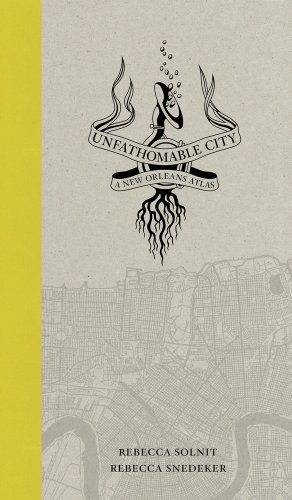Unfathomable City
4 stars
1) "'Fathom' is an Old English word that meant outstretched arms and an embrace by those arms. It came to mean a measurement of about 6 feet, the width a man's arms could reach, as well as the embrace of an idea. To fathom is to understand. Sailors kept the word in circulation as a measurement of depth, and it survives into the present day mostly as a negative, as unfathomable, the water so deep its depths cannot be plumbed, the phenomenon that cannot be fully grasped. New Orleans is all kinds of unfathomable, a city of amorphous boundaries, where land is forever turning into water, water devours land, and a thousand degrees of marshy, muddy, oozing in-between exist; where lines that elsewhere seem firmly drawn are blurry; where whatever you say requires more elaboration; where most rules are full of exceptions the way most land here is full of …
1) "'Fathom' is an Old English word that meant outstretched arms and an embrace by those arms. It came to mean a measurement of about 6 feet, the width a man's arms could reach, as well as the embrace of an idea. To fathom is to understand. Sailors kept the word in circulation as a measurement of depth, and it survives into the present day mostly as a negative, as unfathomable, the water so deep its depths cannot be plumbed, the phenomenon that cannot be fully grasped. New Orleans is all kinds of unfathomable, a city of amorphous boundaries, where land is forever turning into water, water devours land, and a thousand degrees of marshy, muddy, oozing in-between exist; where lines that elsewhere seem firmly drawn are blurry; where whatever you say requires more elaboration; where most rules are full of exceptions the way most land here is full of water. A fathom was an embrace, but you can put your arms around a mystery, and maybe you truly love something only by granting it its full complexity, its unknowability. And maybe love is always an attempt to embrace what cannot be fathomed and to embrace the mystery of it, too. In a sense, every place is unfathomable, infinite, impossible to describe, because it exists in innumerable versions, because no two people live in quite the same city but live side by side in parallel universes that may or may not intersect, because the minute you map it the map becomes obsolete, because the place is constantly arising and decaying. Cincinnati has its enigmas and Albuquerque its contradictions, but New Orleans is particularly rich in these things. We have mapped New Orleans and its surroundings twenty-two times, sometimes with two or more subjects per map, but we have not drained the well with these few bucketloads."
2) "So much of the richness of this place is fleeting and forever being renewed: the pleasures of sociability, of festivals and Carnival, of dancing and music, of smiles and greetings and contact, of improvisations that sail out on the night air never to be recaptured but always to be renewed and succeeded. This is not the immortality of dry endless life but of continual regeneration and reincarnation. The measure of time here is not years or centuries, but the annual cycle that repeats: the old Catholic calendar with Jazz Fest and some other secular occasions thrown in. Not just the Christian holidays celebrated elsewhere in the United States, but the older, richer, wilder calendar, in which Christmas leads to Twelfth Night, and Twelfth Night is the launch of the Carnival season, which runs for many weeks, up until Fat Tuesday. Then the forty days of Lent begin with Ash Wednesday, marching soberly along to Easter—except that few are sober on St. Patrick's Day, and St. Joseph's Day is pleasure galore, with Italians sharing altars of baked goods and Mardi Gras Indians donning their hand-sewn suits that night and one last time the following Sunday—Super Sunday—before they draw a sketch of next year's outfits. The calendar also includes hurricane season, the season when the city's mortality is on everyone's mind."
3) "There are no straight lines in nature. Nor are there any right angles. Rather, intricate tangles and irregular arcs merge and bifurcate recurrently. Look at any plant leaf, or spider web, or the veins of your arm for evidence. Nowhere is this sinuous geometry more apparent than in river deltas, where flowing waters, lacking the discipline that topography imposes, lazily meander in hairpin crescents, ever shifting, eroding, and depositing sediment—until they lunge into an adjacent channel and replicate the process nearby, all the while turning sea into land. So formed the Mississippi Delta, over the span of a mere seven thousand years, producing what Mark Twain called 'the youthfulest batch of country that lies around there anywhere.' Dynamic, fluid, soft, warm, humid, tempestuous: flora and fauna flourish in such conditions, but humans resist them and endeavor to impose rigidity and rectitude upon them, so as to exploit the delta's resources and nodalities. The urban developmental history of New Orleans is essentially the story of overlaying orderly orthogonality on unruly curvaceousness."
4) "At the base of the world's seventh largest river delta, antebellum plantations and petrochemical industries occupy lands where the First Nations of the Mississippi River Delta once lived. The ancient bottomland hardwood and cypress forests exist no more. Where villages once stood, suburbs and cities now sprawl. The federal government has refused to recognize the Houma for over two hundred years, denying us the fulfillment of the promise of colonial treaties. Now, our ancestors' refuge, Rosalie's land, is disappearing before our eyes. For the first time in our history, in the shadows of the BP drilling disaster, we are facing the threat of losing our food sovereignty as we bear witness to the realities of a delta ecosystem under stress. One day, we Houma may be forced to forever evacuate the wetlands of coastal Louisiana that we call home. Until that time, we will continue to make our last stand on sinking land."
5) "In most parts of New Orleans, if you plunge your arm into the ground to the depth of your elbow, your fingertips will touch water. Your fingertips might also touch other fingertips. It took more than a century for the city's early settlers to realize that the ground beneath New Orleans is too low, and the water table too high, to allow traditional Christian burial. As a body decomposes, it fills with gases—cadaverine and putrescine—that cause it to bloat. A coffin containing a bloated corpse will rise through mud like a bubble in a carbonated drink. The only thing holding it back is the hard topsoil. But after a storm, once the topsoil is agitated and diluted, the coffin will pop out of the ground, like a buoy pushed under water and then released. This is what happened for more than a hundred years after New Orleans was founded: every time it rained, bodies popped out of the ground. As late as the mid-nineteenth century, the city was known throughout the United States as the 'Wet Grave.'"
6) "It is these logics of confinement and containment that have shaped New Orleans's approach to public safety for centuries. While it has been forcefully argued that the policies of levees-only and mass incarceration have made southern Louisiana more secure, what these policies have actually done is illuminate whose lives are deemed valuable and who has been rendered disposable time and time again. Yet, regardless of how many policies are enacted, neither human beings nor the river have been easily contained. The urge for freedom is too strong to be put down, no matter how high the walls."
7) "Congo Square, in Treme on the edge of the French Quarter, itself came up in the conversation as the pivotal site for American and perhaps world music. You can imagine the rich musical traditions enslaved Africans brought with them squeezed through the narrow waist of an hourglass—a narrow waist called Congo Square—before broadening out again and mixing and mingling with other sources to become jazz, rhythm and blues, rock and roll, funk, and so much more, including, eventually, hip-hop. And hip-hop is now the global sound of resistance: just as rock and roll played by the Plastic People of the Universe assumed a crucial role in Czechoslovakia's path to liberation, so hip-hop played a meaningful role in the Arab Spring of 2011, which might have as accurately been called the North African Spring. This was only one of the many ways that what began in Africa, survived uniquely in Congo Square, and grew and changed and bloomed in the United States went back to that continent as liberation and power."
8) "Many people fell in love with the city and stayed. In the first few years after Katrina, I met many who told me they came for a week and stayed months or went back and packed up and moved to New Orleans. Newcomers arrived, and many natives discovered a newly fierce affection for their city. Post-Katrina, some racial lines were crossed, some corruption was rooted out, some environmentally strong and hurricane-resistant buildings went in, and some important conversations were launched. The nation learned from it, too, which became evident when Hurricane Sandy struck seven years later and several hundred miles northeast. New Orleans is built on the instability of mud and lowlands, and it is a place of many kinds of violence; but it is also built on love, pleasure, public joy and affection, memory, and faithful attachment. By some estimates, in the wake of the disaster more than a million volunteers visited the city for periods ranging from a few days to years to provide medical care, demolition and construction, community kitchens, advocacy, and more. New Orleans was nearly destroyed by hate, but it was saved and restored by love."

